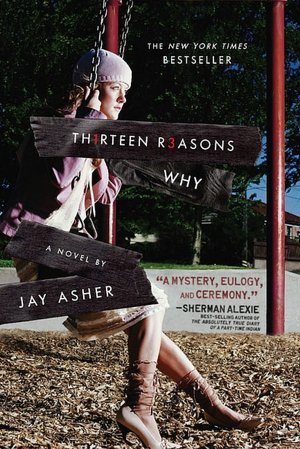
Fiction
288 pages
On tape, Hannah explains that there are thirteen reasons why she decided to end her life. Clay is one of them. If he listens, he'll find out how he made the list.
Through Hannah and Clay's dual narratives, debut author Jay Asher weaves an intricate and heartrending story of confusion and desperation that will deeply affect teen readers.
Grade: B- Must Read
The story of Hannah and Clay is a touching one. I first read it for pleasure and the second time for school. I cried both times, which I think shows some significant skill in a novel, if I might say so myself. I was first interested in the novel for its premise: a boy is sent a set of cassette tapes — recorded by a now dead girl from school — listing the thirteen reasons why she decided to kill herself. While the idea of suicide might drive some people away, I believe this is a sad, emotional story worth reading. This might not be something to own because, hey, I get it — who would want to consistently reread a sad book in order to make it worth the money? — but I do think people do sometimes need a book to remind them how and why to be compassionate and patient with others. The author Asher is smart to not make the other people, the people who made Hannah’s list of reasons, evil or overly dramatic. This book could have easily been unrealistic, preachy, bland, or generic. I believe within the genre he successfully portrayed an emotionally invoking story. I will say that I haven’t read much within this niche — whatever you would call this niche (the dead girl or suicide genre?) — but for one of the few that I have read, it kept my interest, made me emotionally invested, and made me believe in the story. Mind you, I don’t really do contemporary “realistic” books. Real life bores me, normally. So for me to recommend this is a big deal, people. I don’t have much more to say about it really, but if you have the time I would recommend you check it out.
Completion: A
Super easy to read. I finished it in one sitting. During Clay’s narrative, I was sometimes tempted to skim.
Writing/Style: B-
The writing style is very simple, which makes it easy to read but not very memorable on its own. The idea of using dual narratives with Hannah narrating her story on cassette tapes was effective and original.
Characters: B-
I've read this book twice, and although I have been a little dubious of the characters both times, they have inevitably won me over in the end. Clay does come off as a bit bland, and some may say a little too perfect. But, at the end of the day, Clay represents the reader. This is one of the few instances where this truly works. Clay is the average person, the bystander, that could have made a difference, but didn't. He is the narrator but the true focus needs to be on Hannah’s story and the message that everyone had a role to play in her story. Now, at first, Hannah’s vengeful nature didn't seem to ring quite true to someone who committed suicide, but as I read on it became more and more plausible. The author convinces you of it. Hannah is a teenager: angry, sad, confused, hurt, and as we all can be (and probably amplified as a teenager) self-centered. I began to believe that, yeah, there would be a person like Hannah that grows disillusioned with the world, can’t stand to live in it anymore, but still wants to make the people that hurt her pay.
While some may see this novel as suffering from the manic pixie dream girl (a term for a female character that exists only to enlighten the main male character), I believe it proved itself not to. Firstly, Hannah feels like a fully fleshed out character with her own flaws and strengths and invokes emotional empathy/sympathy. Secondly, Clay represents how the reader can make a difference, and as a YA novel, it needs to end on a hopeful note that he might make change in someone else’s life.
Plot/Pacing: B-
The mystery kept the pace moving forward and I was engrossed by Hannah’s story. I will note that the story always slowed slightly when it returned to Clay. As well, I felt Hannah’s reasons were very fitting because they operated on different levels to create a snowball effect (but when I read this for class, there were several people who didn't agree with me on this). It shows how the small things matter, especially when you are teenager absorbed in the present.
World-Building/Atmosphere: C
There are some conveniences to be sure, but overall the building of this town was satisfactory. I didn't really feel like I was there, but I understood what was going on and where things were at.
Sub-genres (Romance, Humor, Mystery, etc.): B
The mystery of Hannah’s suicide drives the reader just as much as the main character Clay. There is little in the realm of romance or humor, but instead the bittersweet of what could have been.
Question Time!
1. What sad or emotional book do you connect with?
2. If sad or emotional books are your thing, any that you would recommend?
No comments:
Post a Comment